Level 2 Certificate: Understanding Quality Standards in Health Sector
VerifiedAdded on 2023/04/22
|19
|5193
|249
Homework Assignment
AI Summary
This Level 2 certificate assignment focuses on understanding quality standards in the health sector. It identifies current quality standards applicable in healthcare roles, including industry and organizational standards, and outlines the roles of regulatory bodies such as the Professional Standards Authority, Medicines and Healthcare Products Regulatory Agency (MHRA), and the Department of Health (DH) in maintaining these standards. The assignment further explains how workplace policies and procedures, such as employee health and safety measures and clinical handover processes, contribute to maintaining quality. It also examines the implications of not meeting quality standards, using scenarios to illustrate potential effects on service quality, service users, and staff. Additionally, the assignment delves into factors affecting service provision, the importance of monitoring and evaluating services, and ways organizations can evaluate service provision. It also highlights the impact of personal attitudes and behaviors on service quality, how healthcare workers can contribute to maintaining standards, and the importance of reporting issues. Finally, it summarizes key points of a complaints policy and methods to raise concerns, emphasizing continuous improvement in healthcare organizations.
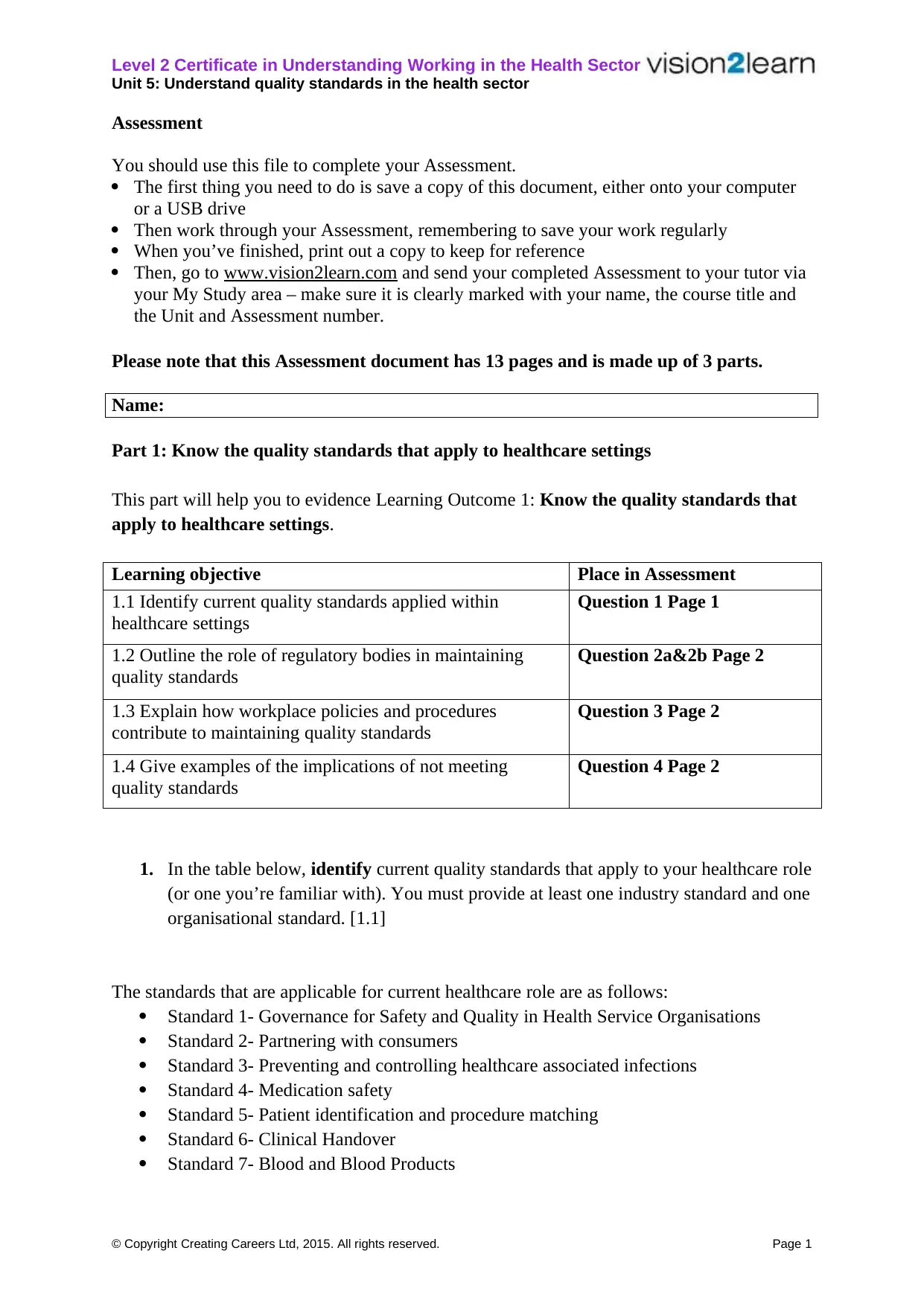
Level 2 Certificate in Understanding Working in the Health Sector
Unit 5: Understand quality standards in the health sector
Assessment
You should use this file to complete your Assessment.
The first thing you need to do is save a copy of this document, either onto your computer
or a USB drive
Then work through your Assessment, remembering to save your work regularly
When you’ve finished, print out a copy to keep for reference
Then, go to www.vision2learn.com and send your completed Assessment to your tutor via
your My Study area – make sure it is clearly marked with your name, the course title and
the Unit and Assessment number.
Please note that this Assessment document has 13 pages and is made up of 3 parts.
Name:
Part 1: Know the quality standards that apply to healthcare settings
This part will help you to evidence Learning Outcome 1: Know the quality standards that
apply to healthcare settings.
Learning objective Place in Assessment
1.1 Identify current quality standards applied within
healthcare settings
Question 1 Page 1
1.2 Outline the role of regulatory bodies in maintaining
quality standards
Question 2a&2b Page 2
1.3 Explain how workplace policies and procedures
contribute to maintaining quality standards
Question 3 Page 2
1.4 Give examples of the implications of not meeting
quality standards
Question 4 Page 2
1. In the table below, identify current quality standards that apply to your healthcare role
(or one you’re familiar with). You must provide at least one industry standard and one
organisational standard. [1.1]
The standards that are applicable for current healthcare role are as follows:
Standard 1- Governance for Safety and Quality in Health Service Organisations
Standard 2- Partnering with consumers
Standard 3- Preventing and controlling healthcare associated infections
Standard 4- Medication safety
Standard 5- Patient identification and procedure matching
Standard 6- Clinical Handover
Standard 7- Blood and Blood Products
© Copyright Creating Careers Ltd, 2015. All rights reserved. Page 1
Unit 5: Understand quality standards in the health sector
Assessment
You should use this file to complete your Assessment.
The first thing you need to do is save a copy of this document, either onto your computer
or a USB drive
Then work through your Assessment, remembering to save your work regularly
When you’ve finished, print out a copy to keep for reference
Then, go to www.vision2learn.com and send your completed Assessment to your tutor via
your My Study area – make sure it is clearly marked with your name, the course title and
the Unit and Assessment number.
Please note that this Assessment document has 13 pages and is made up of 3 parts.
Name:
Part 1: Know the quality standards that apply to healthcare settings
This part will help you to evidence Learning Outcome 1: Know the quality standards that
apply to healthcare settings.
Learning objective Place in Assessment
1.1 Identify current quality standards applied within
healthcare settings
Question 1 Page 1
1.2 Outline the role of regulatory bodies in maintaining
quality standards
Question 2a&2b Page 2
1.3 Explain how workplace policies and procedures
contribute to maintaining quality standards
Question 3 Page 2
1.4 Give examples of the implications of not meeting
quality standards
Question 4 Page 2
1. In the table below, identify current quality standards that apply to your healthcare role
(or one you’re familiar with). You must provide at least one industry standard and one
organisational standard. [1.1]
The standards that are applicable for current healthcare role are as follows:
Standard 1- Governance for Safety and Quality in Health Service Organisations
Standard 2- Partnering with consumers
Standard 3- Preventing and controlling healthcare associated infections
Standard 4- Medication safety
Standard 5- Patient identification and procedure matching
Standard 6- Clinical Handover
Standard 7- Blood and Blood Products
© Copyright Creating Careers Ltd, 2015. All rights reserved. Page 1
Paraphrase This Document
Need a fresh take? Get an instant paraphrase of this document with our AI Paraphraser
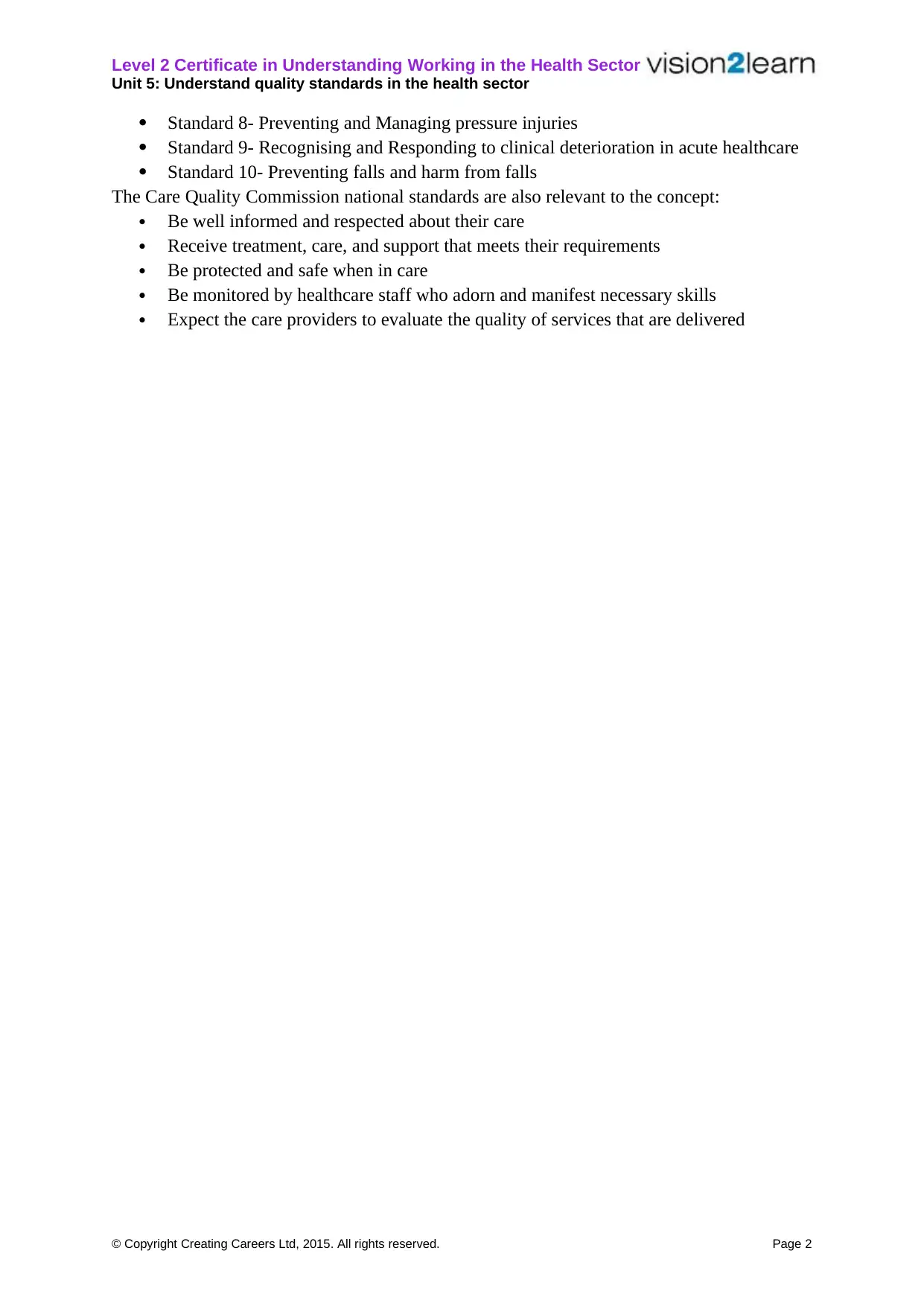
Level 2 Certificate in Understanding Working in the Health Sector
Unit 5: Understand quality standards in the health sector
Standard 8- Preventing and Managing pressure injuries
Standard 9- Recognising and Responding to clinical deterioration in acute healthcare
Standard 10- Preventing falls and harm from falls
The Care Quality Commission national standards are also relevant to the concept:
Be well informed and respected about their care
Receive treatment, care, and support that meets their requirements
Be protected and safe when in care
Be monitored by healthcare staff who adorn and manifest necessary skills
Expect the care providers to evaluate the quality of services that are delivered
© Copyright Creating Careers Ltd, 2015. All rights reserved. Page 2
Unit 5: Understand quality standards in the health sector
Standard 8- Preventing and Managing pressure injuries
Standard 9- Recognising and Responding to clinical deterioration in acute healthcare
Standard 10- Preventing falls and harm from falls
The Care Quality Commission national standards are also relevant to the concept:
Be well informed and respected about their care
Receive treatment, care, and support that meets their requirements
Be protected and safe when in care
Be monitored by healthcare staff who adorn and manifest necessary skills
Expect the care providers to evaluate the quality of services that are delivered
© Copyright Creating Careers Ltd, 2015. All rights reserved. Page 2
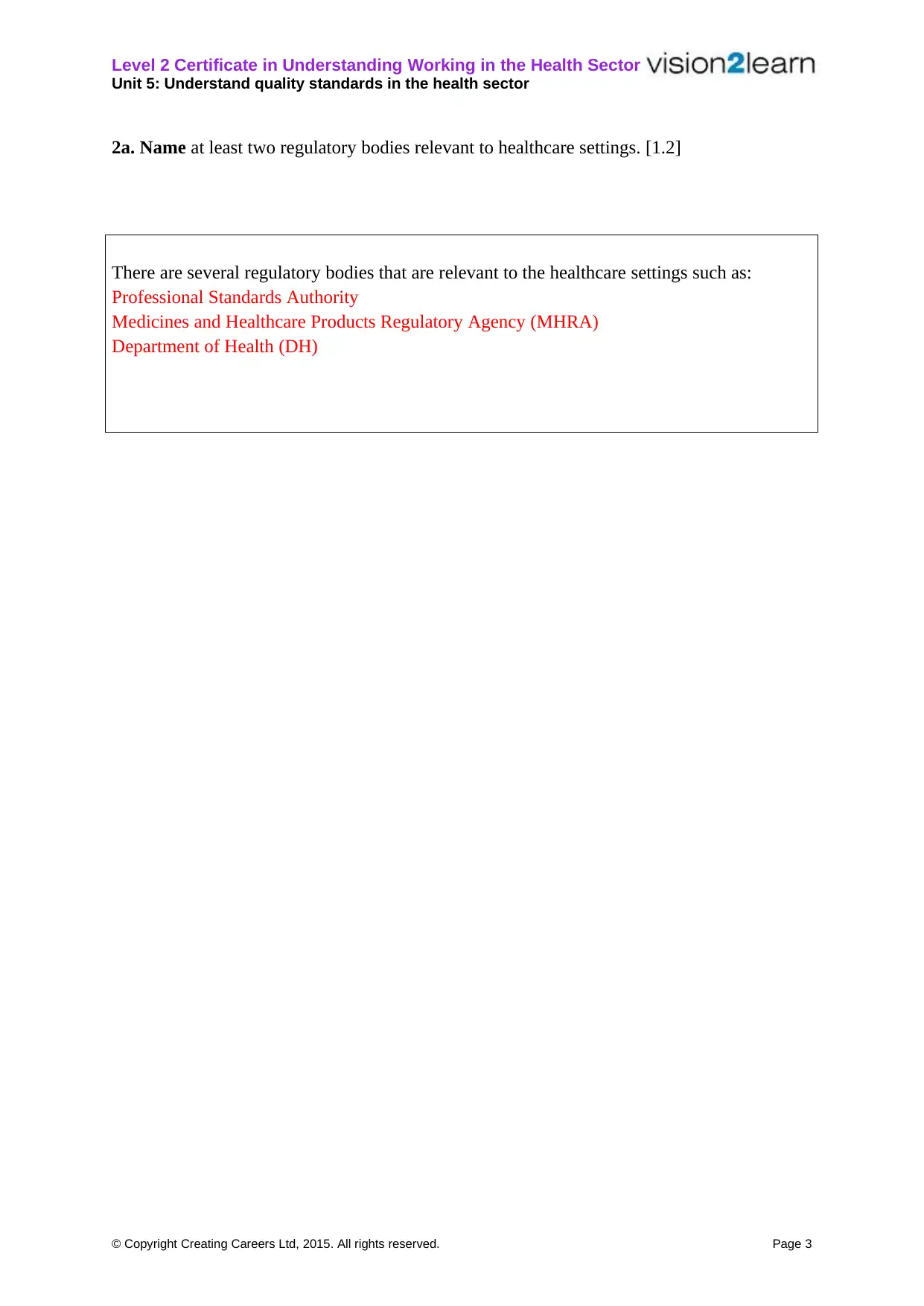
Level 2 Certificate in Understanding Working in the Health Sector
Unit 5: Understand quality standards in the health sector
2a. Name at least two regulatory bodies relevant to healthcare settings. [1.2]
There are several regulatory bodies that are relevant to the healthcare settings such as:
Professional Standards Authority
Medicines and Healthcare Products Regulatory Agency (MHRA)
Department of Health (DH)
© Copyright Creating Careers Ltd, 2015. All rights reserved. Page 3
Unit 5: Understand quality standards in the health sector
2a. Name at least two regulatory bodies relevant to healthcare settings. [1.2]
There are several regulatory bodies that are relevant to the healthcare settings such as:
Professional Standards Authority
Medicines and Healthcare Products Regulatory Agency (MHRA)
Department of Health (DH)
© Copyright Creating Careers Ltd, 2015. All rights reserved. Page 3
⊘ This is a preview!⊘
Do you want full access?
Subscribe today to unlock all pages.

Trusted by 1+ million students worldwide

Level 2 Certificate in Understanding Working in the Health Sector
Unit 5: Understand quality standards in the health sector
2b. Using the examples you came up with for 2a, outline how these regulatory bodies
contribute to maintaining quality standards. [1.2]
Professional Standards Authority- It targets to attain the maximum standard
conceivable on behalf of healthcare facility consumers in the UK. It supervises
statutory organisations that control health and social care specialists and also
document their performance assessment to the parliament.
Medicines and Healthcare Products Regulatory Agency (MHRA)- It regulates the
usage of drugs and medical devices with the use of science and research for detecting
areas that need improvement.
Department of Health (DH)- It progresses healthcare service in a determination to aid
persons live an improved quality of life for a prolonged duration. It also safeguards
that each patient obtains the care and treatment they want in a innocuous and secure
setting.
3. Using the table below, explain how relevant workplace policies and procedures contribute
to maintaining quality standards. [1.3]
Policy / procedure Who is affected? How does it maintain
quality standards?
Employee health safety
measures Medical Staff Preventing and controlling
healthcare associated
infections
Clinical handover Medical Staff
Clinical handover refers to
the transfer of professional
responsibility and
accountability for some or all
aspects of care for a patient,
or group of patients, to
another person or
professional group on a
temporary or permanent
basis.
© Copyright Creating Careers Ltd, 2015. All rights reserved. Page 4
Unit 5: Understand quality standards in the health sector
2b. Using the examples you came up with for 2a, outline how these regulatory bodies
contribute to maintaining quality standards. [1.2]
Professional Standards Authority- It targets to attain the maximum standard
conceivable on behalf of healthcare facility consumers in the UK. It supervises
statutory organisations that control health and social care specialists and also
document their performance assessment to the parliament.
Medicines and Healthcare Products Regulatory Agency (MHRA)- It regulates the
usage of drugs and medical devices with the use of science and research for detecting
areas that need improvement.
Department of Health (DH)- It progresses healthcare service in a determination to aid
persons live an improved quality of life for a prolonged duration. It also safeguards
that each patient obtains the care and treatment they want in a innocuous and secure
setting.
3. Using the table below, explain how relevant workplace policies and procedures contribute
to maintaining quality standards. [1.3]
Policy / procedure Who is affected? How does it maintain
quality standards?
Employee health safety
measures Medical Staff Preventing and controlling
healthcare associated
infections
Clinical handover Medical Staff
Clinical handover refers to
the transfer of professional
responsibility and
accountability for some or all
aspects of care for a patient,
or group of patients, to
another person or
professional group on a
temporary or permanent
basis.
© Copyright Creating Careers Ltd, 2015. All rights reserved. Page 4
Paraphrase This Document
Need a fresh take? Get an instant paraphrase of this document with our AI Paraphraser
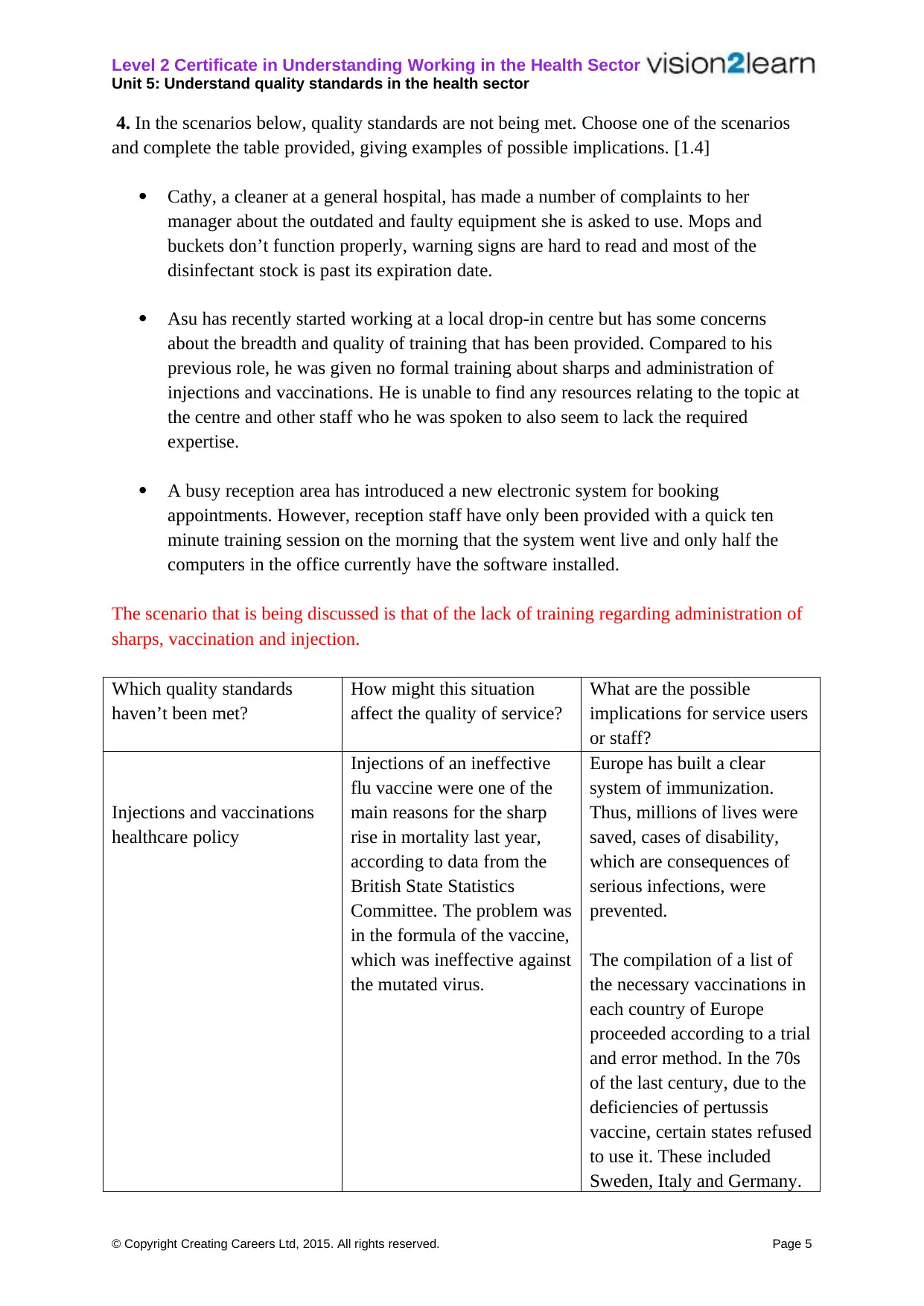
Level 2 Certificate in Understanding Working in the Health Sector
Unit 5: Understand quality standards in the health sector
4. In the scenarios below, quality standards are not being met. Choose one of the scenarios
and complete the table provided, giving examples of possible implications. [1.4]
Cathy, a cleaner at a general hospital, has made a number of complaints to her
manager about the outdated and faulty equipment she is asked to use. Mops and
buckets don’t function properly, warning signs are hard to read and most of the
disinfectant stock is past its expiration date.
Asu has recently started working at a local drop-in centre but has some concerns
about the breadth and quality of training that has been provided. Compared to his
previous role, he was given no formal training about sharps and administration of
injections and vaccinations. He is unable to find any resources relating to the topic at
the centre and other staff who he was spoken to also seem to lack the required
expertise.
A busy reception area has introduced a new electronic system for booking
appointments. However, reception staff have only been provided with a quick ten
minute training session on the morning that the system went live and only half the
computers in the office currently have the software installed.
The scenario that is being discussed is that of the lack of training regarding administration of
sharps, vaccination and injection.
Which quality standards
haven’t been met?
How might this situation
affect the quality of service?
What are the possible
implications for service users
or staff?
Injections and vaccinations
healthcare policy
Injections of an ineffective
flu vaccine were one of the
main reasons for the sharp
rise in mortality last year,
according to data from the
British State Statistics
Committee. The problem was
in the formula of the vaccine,
which was ineffective against
the mutated virus.
Europe has built a clear
system of immunization.
Thus, millions of lives were
saved, cases of disability,
which are consequences of
serious infections, were
prevented.
The compilation of a list of
the necessary vaccinations in
each country of Europe
proceeded according to a trial
and error method. In the 70s
of the last century, due to the
deficiencies of pertussis
vaccine, certain states refused
to use it. These included
Sweden, Italy and Germany.
© Copyright Creating Careers Ltd, 2015. All rights reserved. Page 5
Unit 5: Understand quality standards in the health sector
4. In the scenarios below, quality standards are not being met. Choose one of the scenarios
and complete the table provided, giving examples of possible implications. [1.4]
Cathy, a cleaner at a general hospital, has made a number of complaints to her
manager about the outdated and faulty equipment she is asked to use. Mops and
buckets don’t function properly, warning signs are hard to read and most of the
disinfectant stock is past its expiration date.
Asu has recently started working at a local drop-in centre but has some concerns
about the breadth and quality of training that has been provided. Compared to his
previous role, he was given no formal training about sharps and administration of
injections and vaccinations. He is unable to find any resources relating to the topic at
the centre and other staff who he was spoken to also seem to lack the required
expertise.
A busy reception area has introduced a new electronic system for booking
appointments. However, reception staff have only been provided with a quick ten
minute training session on the morning that the system went live and only half the
computers in the office currently have the software installed.
The scenario that is being discussed is that of the lack of training regarding administration of
sharps, vaccination and injection.
Which quality standards
haven’t been met?
How might this situation
affect the quality of service?
What are the possible
implications for service users
or staff?
Injections and vaccinations
healthcare policy
Injections of an ineffective
flu vaccine were one of the
main reasons for the sharp
rise in mortality last year,
according to data from the
British State Statistics
Committee. The problem was
in the formula of the vaccine,
which was ineffective against
the mutated virus.
Europe has built a clear
system of immunization.
Thus, millions of lives were
saved, cases of disability,
which are consequences of
serious infections, were
prevented.
The compilation of a list of
the necessary vaccinations in
each country of Europe
proceeded according to a trial
and error method. In the 70s
of the last century, due to the
deficiencies of pertussis
vaccine, certain states refused
to use it. These included
Sweden, Italy and Germany.
© Copyright Creating Careers Ltd, 2015. All rights reserved. Page 5
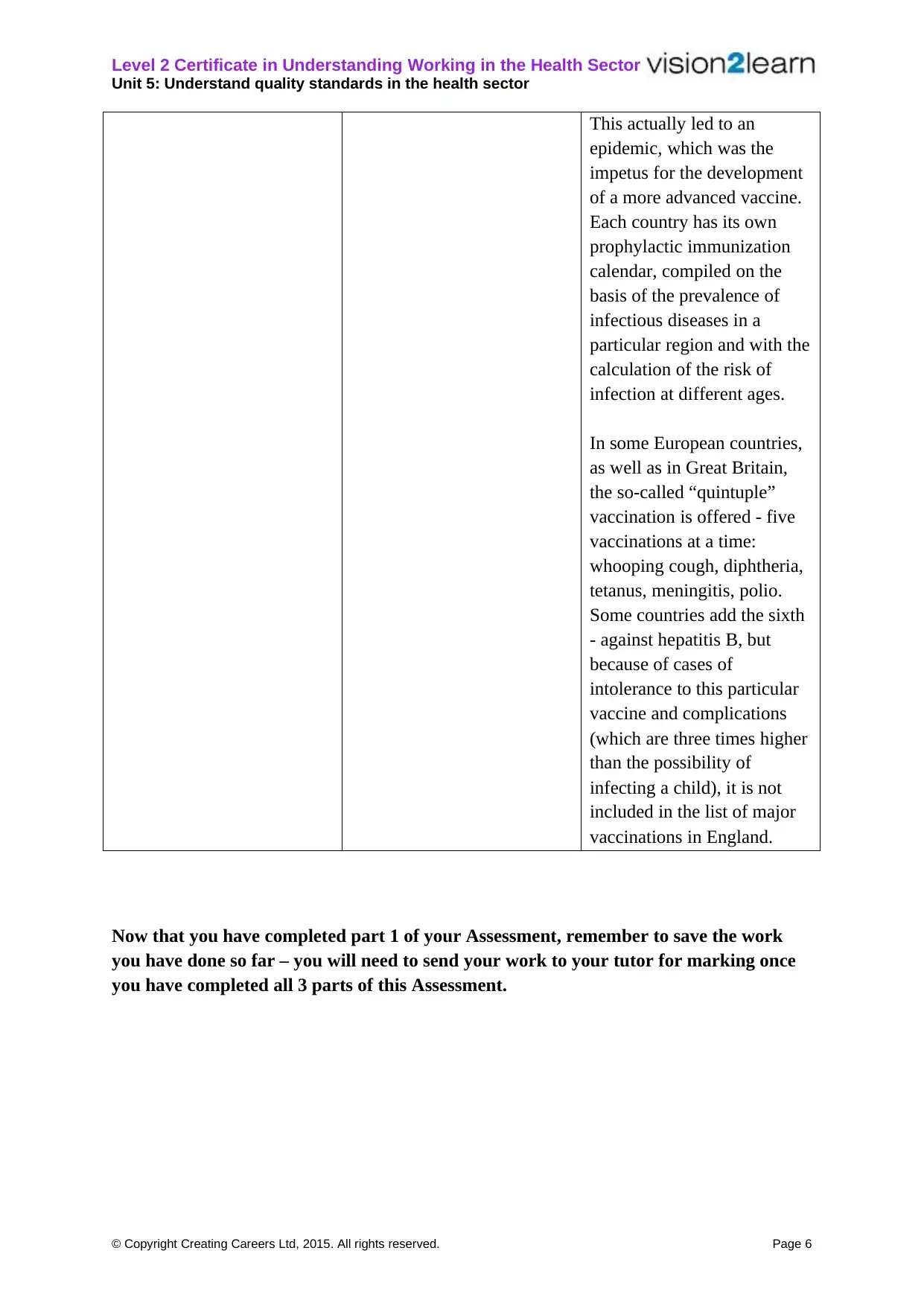
Level 2 Certificate in Understanding Working in the Health Sector
Unit 5: Understand quality standards in the health sector
This actually led to an
epidemic, which was the
impetus for the development
of a more advanced vaccine.
Each country has its own
prophylactic immunization
calendar, compiled on the
basis of the prevalence of
infectious diseases in a
particular region and with the
calculation of the risk of
infection at different ages.
In some European countries,
as well as in Great Britain,
the so-called “quintuple”
vaccination is offered - five
vaccinations at a time:
whooping cough, diphtheria,
tetanus, meningitis, polio.
Some countries add the sixth
- against hepatitis B, but
because of cases of
intolerance to this particular
vaccine and complications
(which are three times higher
than the possibility of
infecting a child), it is not
included in the list of major
vaccinations in England.
Now that you have completed part 1 of your Assessment, remember to save the work
you have done so far – you will need to send your work to your tutor for marking once
you have completed all 3 parts of this Assessment.
© Copyright Creating Careers Ltd, 2015. All rights reserved. Page 6
Unit 5: Understand quality standards in the health sector
This actually led to an
epidemic, which was the
impetus for the development
of a more advanced vaccine.
Each country has its own
prophylactic immunization
calendar, compiled on the
basis of the prevalence of
infectious diseases in a
particular region and with the
calculation of the risk of
infection at different ages.
In some European countries,
as well as in Great Britain,
the so-called “quintuple”
vaccination is offered - five
vaccinations at a time:
whooping cough, diphtheria,
tetanus, meningitis, polio.
Some countries add the sixth
- against hepatitis B, but
because of cases of
intolerance to this particular
vaccine and complications
(which are three times higher
than the possibility of
infecting a child), it is not
included in the list of major
vaccinations in England.
Now that you have completed part 1 of your Assessment, remember to save the work
you have done so far – you will need to send your work to your tutor for marking once
you have completed all 3 parts of this Assessment.
© Copyright Creating Careers Ltd, 2015. All rights reserved. Page 6
⊘ This is a preview!⊘
Do you want full access?
Subscribe today to unlock all pages.

Trusted by 1+ million students worldwide
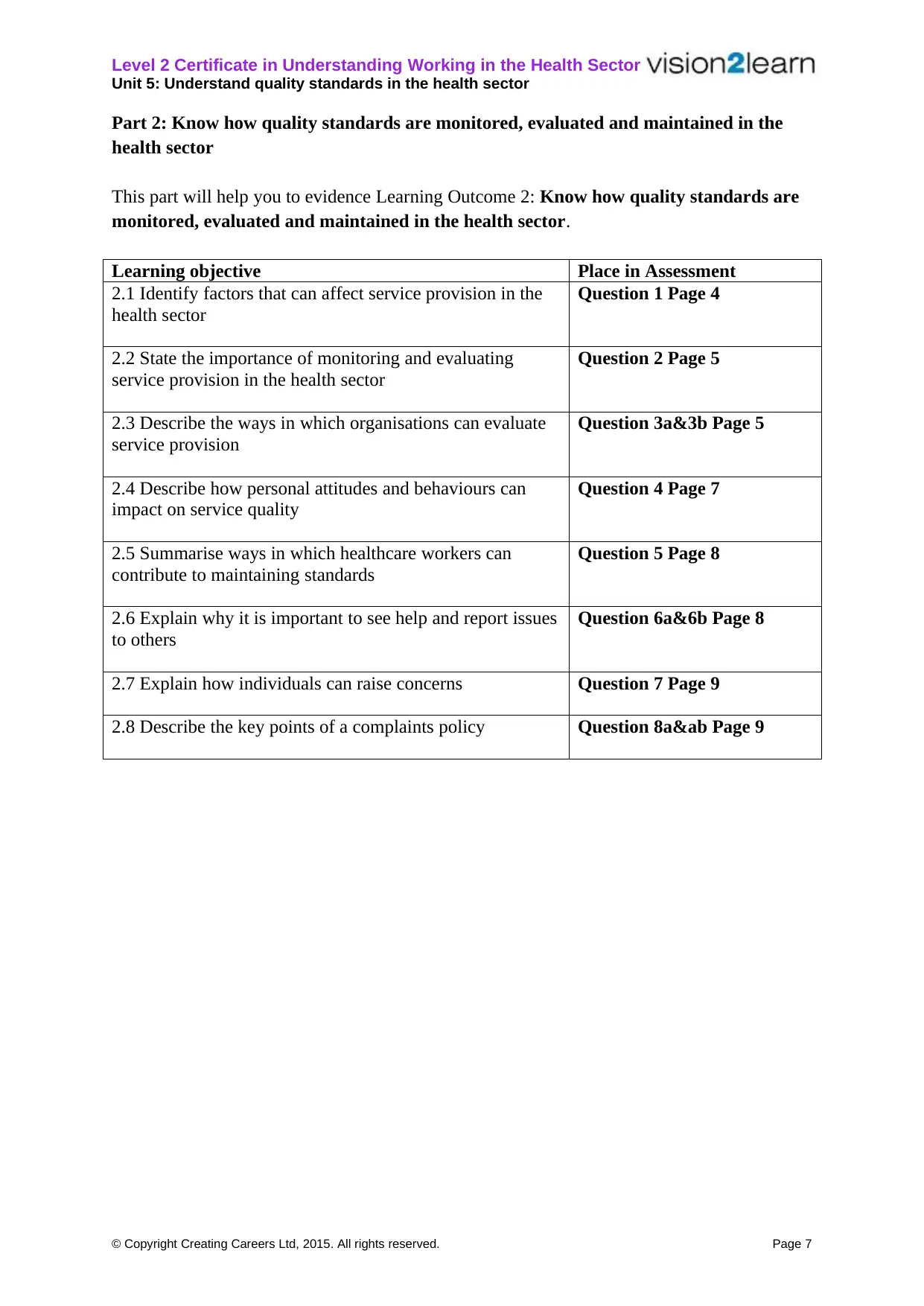
Level 2 Certificate in Understanding Working in the Health Sector
Unit 5: Understand quality standards in the health sector
Part 2: Know how quality standards are monitored, evaluated and maintained in the
health sector
This part will help you to evidence Learning Outcome 2: Know how quality standards are
monitored, evaluated and maintained in the health sector.
Learning objective Place in Assessment
2.1 Identify factors that can affect service provision in the
health sector
Question 1 Page 4
2.2 State the importance of monitoring and evaluating
service provision in the health sector
Question 2 Page 5
2.3 Describe the ways in which organisations can evaluate
service provision
Question 3a&3b Page 5
2.4 Describe how personal attitudes and behaviours can
impact on service quality
Question 4 Page 7
2.5 Summarise ways in which healthcare workers can
contribute to maintaining standards
Question 5 Page 8
2.6 Explain why it is important to see help and report issues
to others
Question 6a&6b Page 8
2.7 Explain how individuals can raise concerns Question 7 Page 9
2.8 Describe the key points of a complaints policy Question 8a&ab Page 9
© Copyright Creating Careers Ltd, 2015. All rights reserved. Page 7
Unit 5: Understand quality standards in the health sector
Part 2: Know how quality standards are monitored, evaluated and maintained in the
health sector
This part will help you to evidence Learning Outcome 2: Know how quality standards are
monitored, evaluated and maintained in the health sector.
Learning objective Place in Assessment
2.1 Identify factors that can affect service provision in the
health sector
Question 1 Page 4
2.2 State the importance of monitoring and evaluating
service provision in the health sector
Question 2 Page 5
2.3 Describe the ways in which organisations can evaluate
service provision
Question 3a&3b Page 5
2.4 Describe how personal attitudes and behaviours can
impact on service quality
Question 4 Page 7
2.5 Summarise ways in which healthcare workers can
contribute to maintaining standards
Question 5 Page 8
2.6 Explain why it is important to see help and report issues
to others
Question 6a&6b Page 8
2.7 Explain how individuals can raise concerns Question 7 Page 9
2.8 Describe the key points of a complaints policy Question 8a&ab Page 9
© Copyright Creating Careers Ltd, 2015. All rights reserved. Page 7
Paraphrase This Document
Need a fresh take? Get an instant paraphrase of this document with our AI Paraphraser
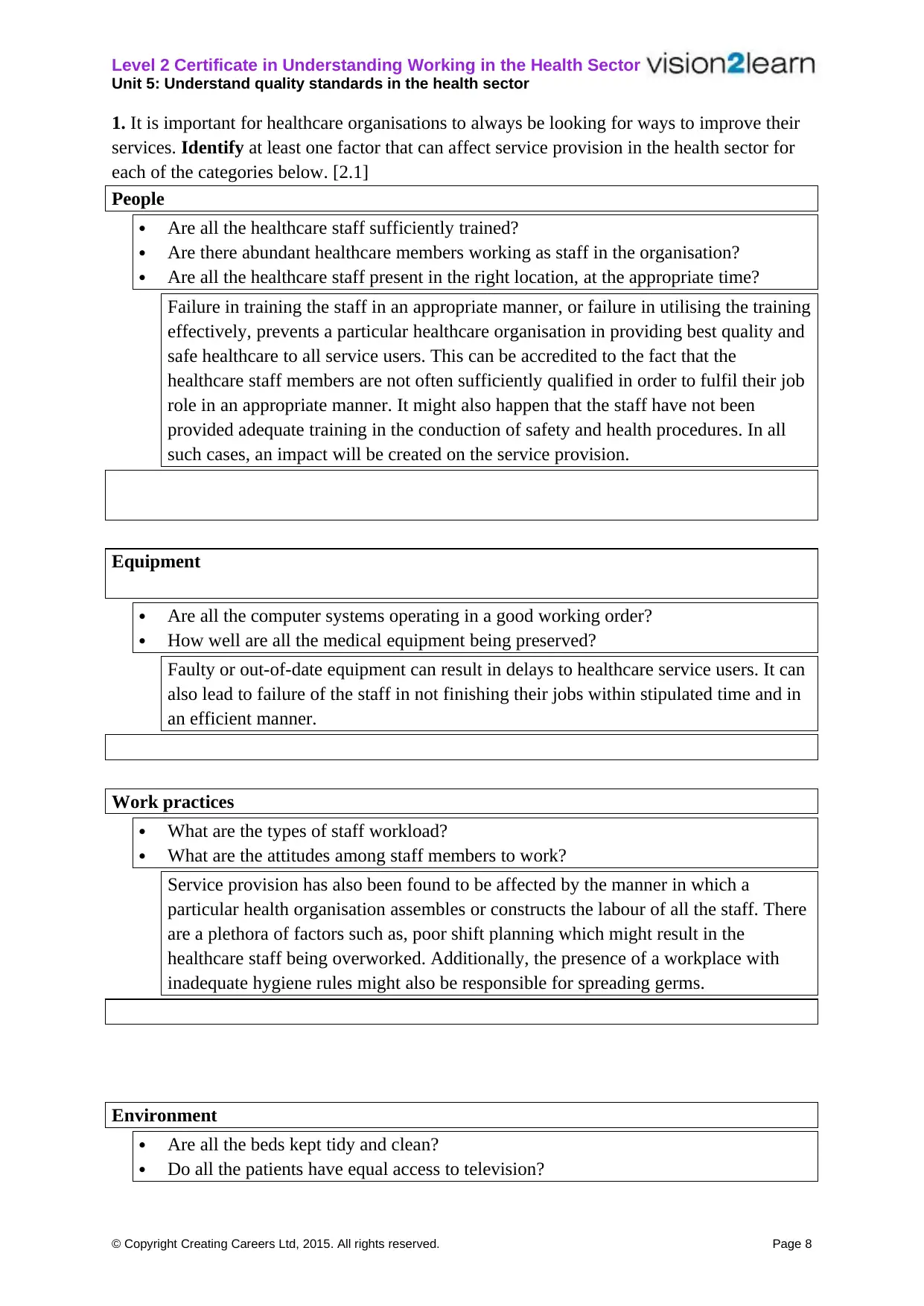
Level 2 Certificate in Understanding Working in the Health Sector
Unit 5: Understand quality standards in the health sector
1. It is important for healthcare organisations to always be looking for ways to improve their
services. Identify at least one factor that can affect service provision in the health sector for
each of the categories below. [2.1]
People
Are all the healthcare staff sufficiently trained?
Are there abundant healthcare members working as staff in the organisation?
Are all the healthcare staff present in the right location, at the appropriate time?
Failure in training the staff in an appropriate manner, or failure in utilising the training
effectively, prevents a particular healthcare organisation in providing best quality and
safe healthcare to all service users. This can be accredited to the fact that the
healthcare staff members are not often sufficiently qualified in order to fulfil their job
role in an appropriate manner. It might also happen that the staff have not been
provided adequate training in the conduction of safety and health procedures. In all
such cases, an impact will be created on the service provision.
Equipment
Are all the computer systems operating in a good working order?
How well are all the medical equipment being preserved?
Faulty or out-of-date equipment can result in delays to healthcare service users. It can
also lead to failure of the staff in not finishing their jobs within stipulated time and in
an efficient manner.
Work practices
What are the types of staff workload?
What are the attitudes among staff members to work?
Service provision has also been found to be affected by the manner in which a
particular health organisation assembles or constructs the labour of all the staff. There
are a plethora of factors such as, poor shift planning which might result in the
healthcare staff being overworked. Additionally, the presence of a workplace with
inadequate hygiene rules might also be responsible for spreading germs.
Environment
Are all the beds kept tidy and clean?
Do all the patients have equal access to television?
© Copyright Creating Careers Ltd, 2015. All rights reserved. Page 8
Unit 5: Understand quality standards in the health sector
1. It is important for healthcare organisations to always be looking for ways to improve their
services. Identify at least one factor that can affect service provision in the health sector for
each of the categories below. [2.1]
People
Are all the healthcare staff sufficiently trained?
Are there abundant healthcare members working as staff in the organisation?
Are all the healthcare staff present in the right location, at the appropriate time?
Failure in training the staff in an appropriate manner, or failure in utilising the training
effectively, prevents a particular healthcare organisation in providing best quality and
safe healthcare to all service users. This can be accredited to the fact that the
healthcare staff members are not often sufficiently qualified in order to fulfil their job
role in an appropriate manner. It might also happen that the staff have not been
provided adequate training in the conduction of safety and health procedures. In all
such cases, an impact will be created on the service provision.
Equipment
Are all the computer systems operating in a good working order?
How well are all the medical equipment being preserved?
Faulty or out-of-date equipment can result in delays to healthcare service users. It can
also lead to failure of the staff in not finishing their jobs within stipulated time and in
an efficient manner.
Work practices
What are the types of staff workload?
What are the attitudes among staff members to work?
Service provision has also been found to be affected by the manner in which a
particular health organisation assembles or constructs the labour of all the staff. There
are a plethora of factors such as, poor shift planning which might result in the
healthcare staff being overworked. Additionally, the presence of a workplace with
inadequate hygiene rules might also be responsible for spreading germs.
Environment
Are all the beds kept tidy and clean?
Do all the patients have equal access to television?
© Copyright Creating Careers Ltd, 2015. All rights reserved. Page 8
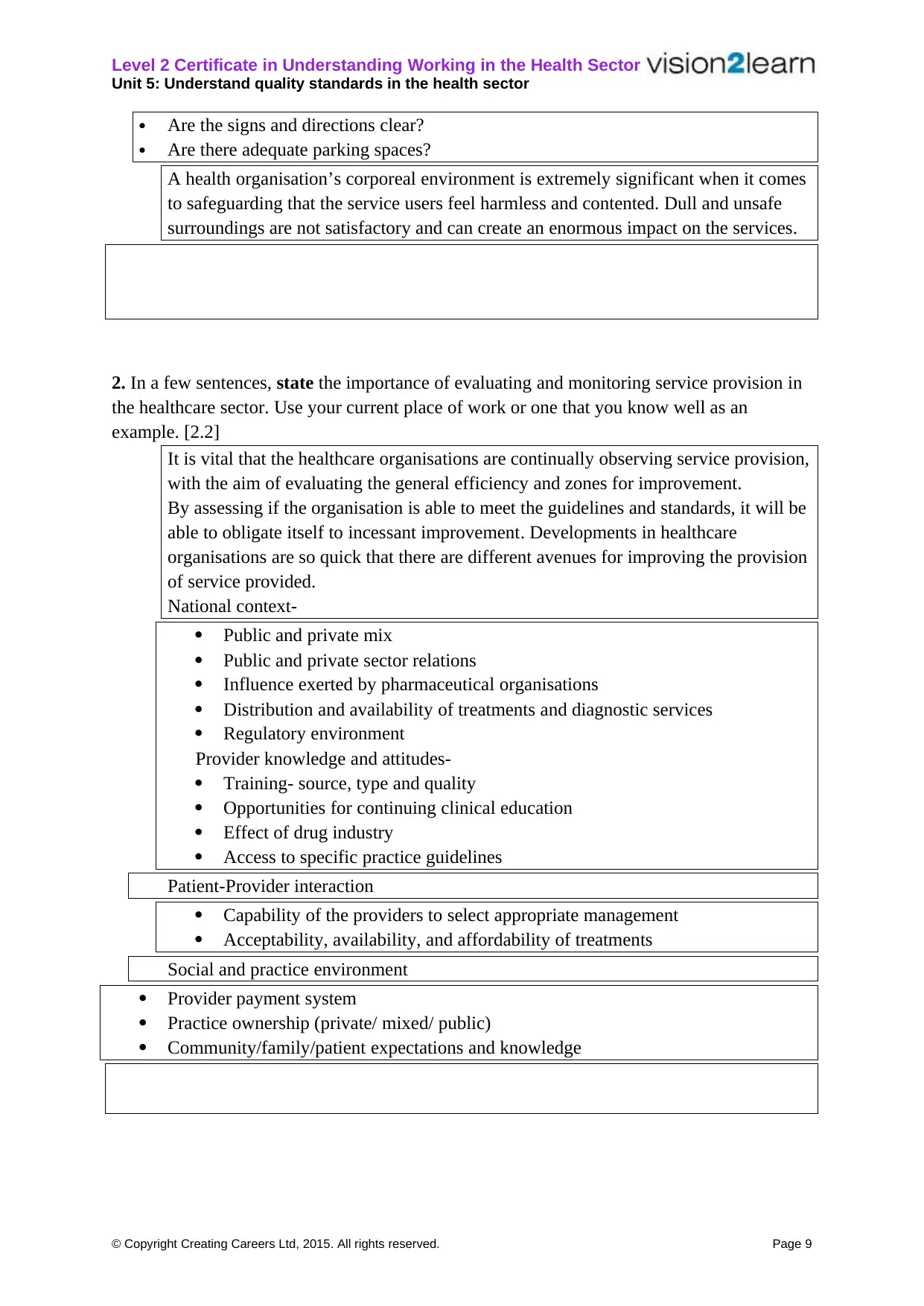
Level 2 Certificate in Understanding Working in the Health Sector
Unit 5: Understand quality standards in the health sector
Are the signs and directions clear?
Are there adequate parking spaces?
A health organisation’s corporeal environment is extremely significant when it comes
to safeguarding that the service users feel harmless and contented. Dull and unsafe
surroundings are not satisfactory and can create an enormous impact on the services.
2. In a few sentences, state the importance of evaluating and monitoring service provision in
the healthcare sector. Use your current place of work or one that you know well as an
example. [2.2]
It is vital that the healthcare organisations are continually observing service provision,
with the aim of evaluating the general efficiency and zones for improvement.
By assessing if the organisation is able to meet the guidelines and standards, it will be
able to obligate itself to incessant improvement. Developments in healthcare
organisations are so quick that there are different avenues for improving the provision
of service provided.
National context-
Public and private mix
Public and private sector relations
Influence exerted by pharmaceutical organisations
Distribution and availability of treatments and diagnostic services
Regulatory environment
Provider knowledge and attitudes-
Training- source, type and quality
Opportunities for continuing clinical education
Effect of drug industry
Access to specific practice guidelines
Patient-Provider interaction
Capability of the providers to select appropriate management
Acceptability, availability, and affordability of treatments
Social and practice environment
Provider payment system
Practice ownership (private/ mixed/ public)
Community/family/patient expectations and knowledge
© Copyright Creating Careers Ltd, 2015. All rights reserved. Page 9
Unit 5: Understand quality standards in the health sector
Are the signs and directions clear?
Are there adequate parking spaces?
A health organisation’s corporeal environment is extremely significant when it comes
to safeguarding that the service users feel harmless and contented. Dull and unsafe
surroundings are not satisfactory and can create an enormous impact on the services.
2. In a few sentences, state the importance of evaluating and monitoring service provision in
the healthcare sector. Use your current place of work or one that you know well as an
example. [2.2]
It is vital that the healthcare organisations are continually observing service provision,
with the aim of evaluating the general efficiency and zones for improvement.
By assessing if the organisation is able to meet the guidelines and standards, it will be
able to obligate itself to incessant improvement. Developments in healthcare
organisations are so quick that there are different avenues for improving the provision
of service provided.
National context-
Public and private mix
Public and private sector relations
Influence exerted by pharmaceutical organisations
Distribution and availability of treatments and diagnostic services
Regulatory environment
Provider knowledge and attitudes-
Training- source, type and quality
Opportunities for continuing clinical education
Effect of drug industry
Access to specific practice guidelines
Patient-Provider interaction
Capability of the providers to select appropriate management
Acceptability, availability, and affordability of treatments
Social and practice environment
Provider payment system
Practice ownership (private/ mixed/ public)
Community/family/patient expectations and knowledge
© Copyright Creating Careers Ltd, 2015. All rights reserved. Page 9
⊘ This is a preview!⊘
Do you want full access?
Subscribe today to unlock all pages.

Trusted by 1+ million students worldwide
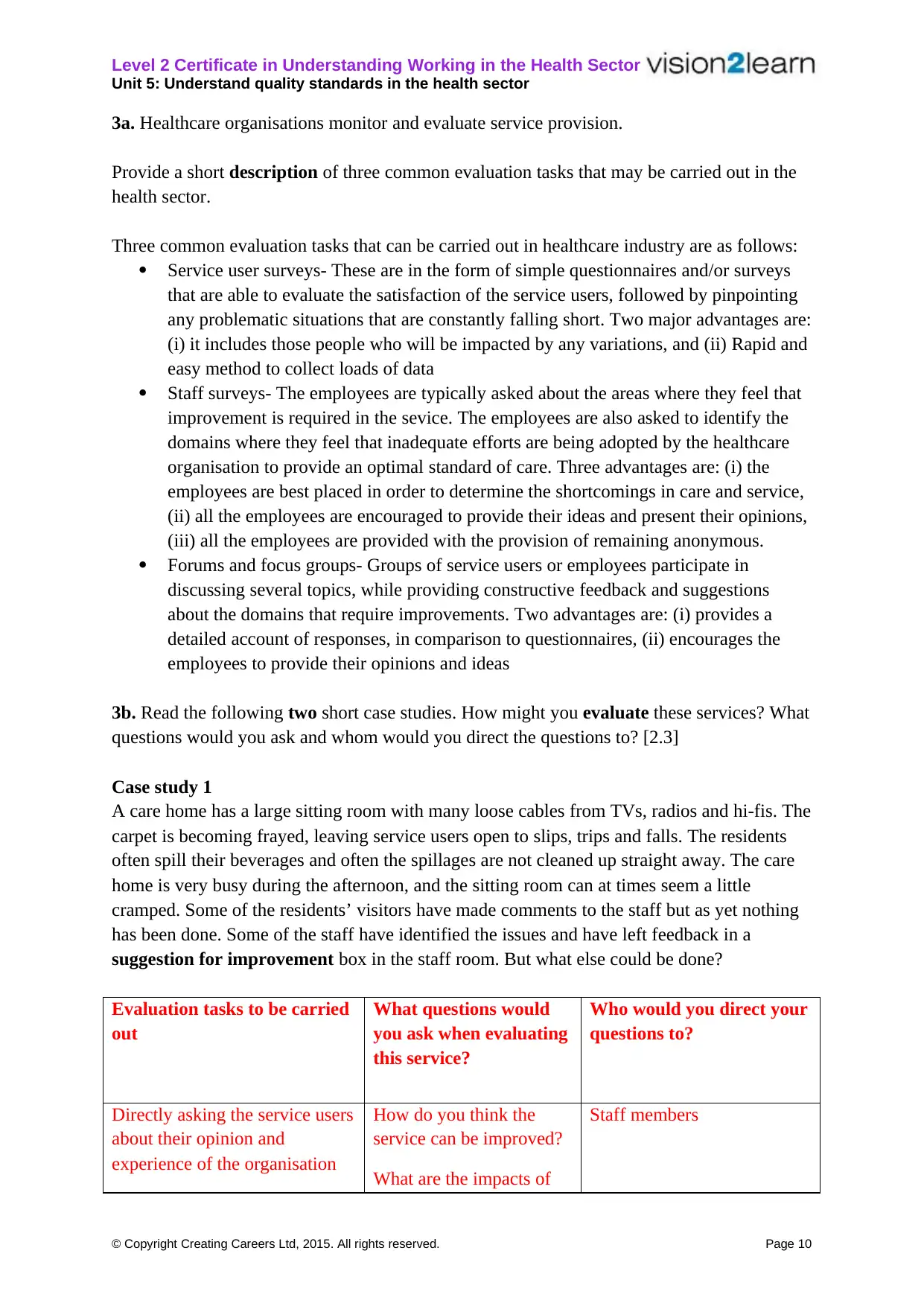
Level 2 Certificate in Understanding Working in the Health Sector
Unit 5: Understand quality standards in the health sector
3a. Healthcare organisations monitor and evaluate service provision.
Provide a short description of three common evaluation tasks that may be carried out in the
health sector.
Three common evaluation tasks that can be carried out in healthcare industry are as follows:
Service user surveys- These are in the form of simple questionnaires and/or surveys
that are able to evaluate the satisfaction of the service users, followed by pinpointing
any problematic situations that are constantly falling short. Two major advantages are:
(i) it includes those people who will be impacted by any variations, and (ii) Rapid and
easy method to collect loads of data
Staff surveys- The employees are typically asked about the areas where they feel that
improvement is required in the sevice. The employees are also asked to identify the
domains where they feel that inadequate efforts are being adopted by the healthcare
organisation to provide an optimal standard of care. Three advantages are: (i) the
employees are best placed in order to determine the shortcomings in care and service,
(ii) all the employees are encouraged to provide their ideas and present their opinions,
(iii) all the employees are provided with the provision of remaining anonymous.
Forums and focus groups- Groups of service users or employees participate in
discussing several topics, while providing constructive feedback and suggestions
about the domains that require improvements. Two advantages are: (i) provides a
detailed account of responses, in comparison to questionnaires, (ii) encourages the
employees to provide their opinions and ideas
3b. Read the following two short case studies. How might you evaluate these services? What
questions would you ask and whom would you direct the questions to? [2.3]
Case study 1
A care home has a large sitting room with many loose cables from TVs, radios and hi-fis. The
carpet is becoming frayed, leaving service users open to slips, trips and falls. The residents
often spill their beverages and often the spillages are not cleaned up straight away. The care
home is very busy during the afternoon, and the sitting room can at times seem a little
cramped. Some of the residents’ visitors have made comments to the staff but as yet nothing
has been done. Some of the staff have identified the issues and have left feedback in a
suggestion for improvement box in the staff room. But what else could be done?
Evaluation tasks to be carried
out
What questions would
you ask when evaluating
this service?
Who would you direct your
questions to?
Directly asking the service users
about their opinion and
experience of the organisation
How do you think the
service can be improved?
What are the impacts of
Staff members
© Copyright Creating Careers Ltd, 2015. All rights reserved. Page 10
Unit 5: Understand quality standards in the health sector
3a. Healthcare organisations monitor and evaluate service provision.
Provide a short description of three common evaluation tasks that may be carried out in the
health sector.
Three common evaluation tasks that can be carried out in healthcare industry are as follows:
Service user surveys- These are in the form of simple questionnaires and/or surveys
that are able to evaluate the satisfaction of the service users, followed by pinpointing
any problematic situations that are constantly falling short. Two major advantages are:
(i) it includes those people who will be impacted by any variations, and (ii) Rapid and
easy method to collect loads of data
Staff surveys- The employees are typically asked about the areas where they feel that
improvement is required in the sevice. The employees are also asked to identify the
domains where they feel that inadequate efforts are being adopted by the healthcare
organisation to provide an optimal standard of care. Three advantages are: (i) the
employees are best placed in order to determine the shortcomings in care and service,
(ii) all the employees are encouraged to provide their ideas and present their opinions,
(iii) all the employees are provided with the provision of remaining anonymous.
Forums and focus groups- Groups of service users or employees participate in
discussing several topics, while providing constructive feedback and suggestions
about the domains that require improvements. Two advantages are: (i) provides a
detailed account of responses, in comparison to questionnaires, (ii) encourages the
employees to provide their opinions and ideas
3b. Read the following two short case studies. How might you evaluate these services? What
questions would you ask and whom would you direct the questions to? [2.3]
Case study 1
A care home has a large sitting room with many loose cables from TVs, radios and hi-fis. The
carpet is becoming frayed, leaving service users open to slips, trips and falls. The residents
often spill their beverages and often the spillages are not cleaned up straight away. The care
home is very busy during the afternoon, and the sitting room can at times seem a little
cramped. Some of the residents’ visitors have made comments to the staff but as yet nothing
has been done. Some of the staff have identified the issues and have left feedback in a
suggestion for improvement box in the staff room. But what else could be done?
Evaluation tasks to be carried
out
What questions would
you ask when evaluating
this service?
Who would you direct your
questions to?
Directly asking the service users
about their opinion and
experience of the organisation
How do you think the
service can be improved?
What are the impacts of
Staff members
© Copyright Creating Careers Ltd, 2015. All rights reserved. Page 10
Paraphrase This Document
Need a fresh take? Get an instant paraphrase of this document with our AI Paraphraser
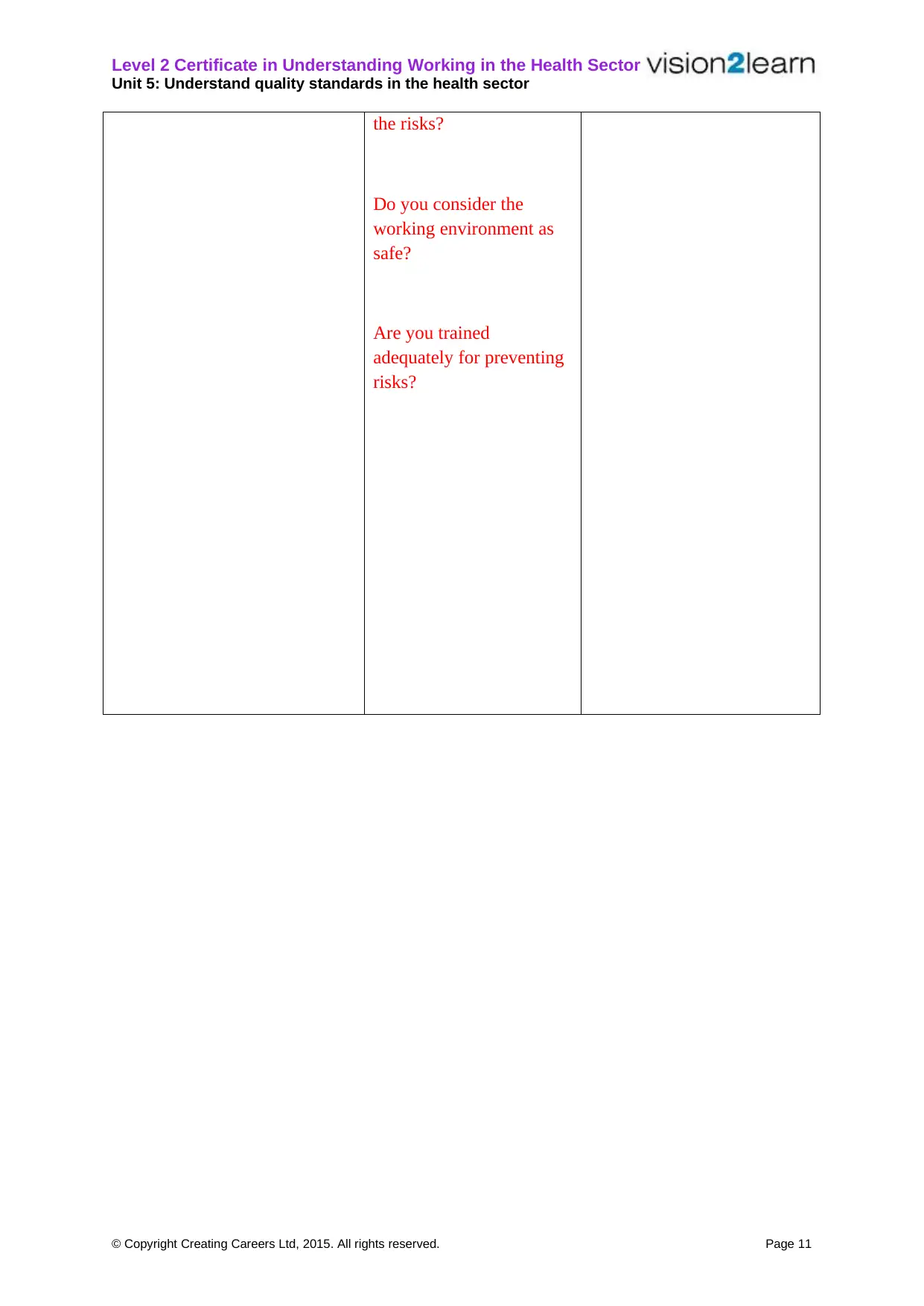
Level 2 Certificate in Understanding Working in the Health Sector
Unit 5: Understand quality standards in the health sector
the risks?
Do you consider the
working environment as
safe?
Are you trained
adequately for preventing
risks?
© Copyright Creating Careers Ltd, 2015. All rights reserved. Page 11
Unit 5: Understand quality standards in the health sector
the risks?
Do you consider the
working environment as
safe?
Are you trained
adequately for preventing
risks?
© Copyright Creating Careers Ltd, 2015. All rights reserved. Page 11
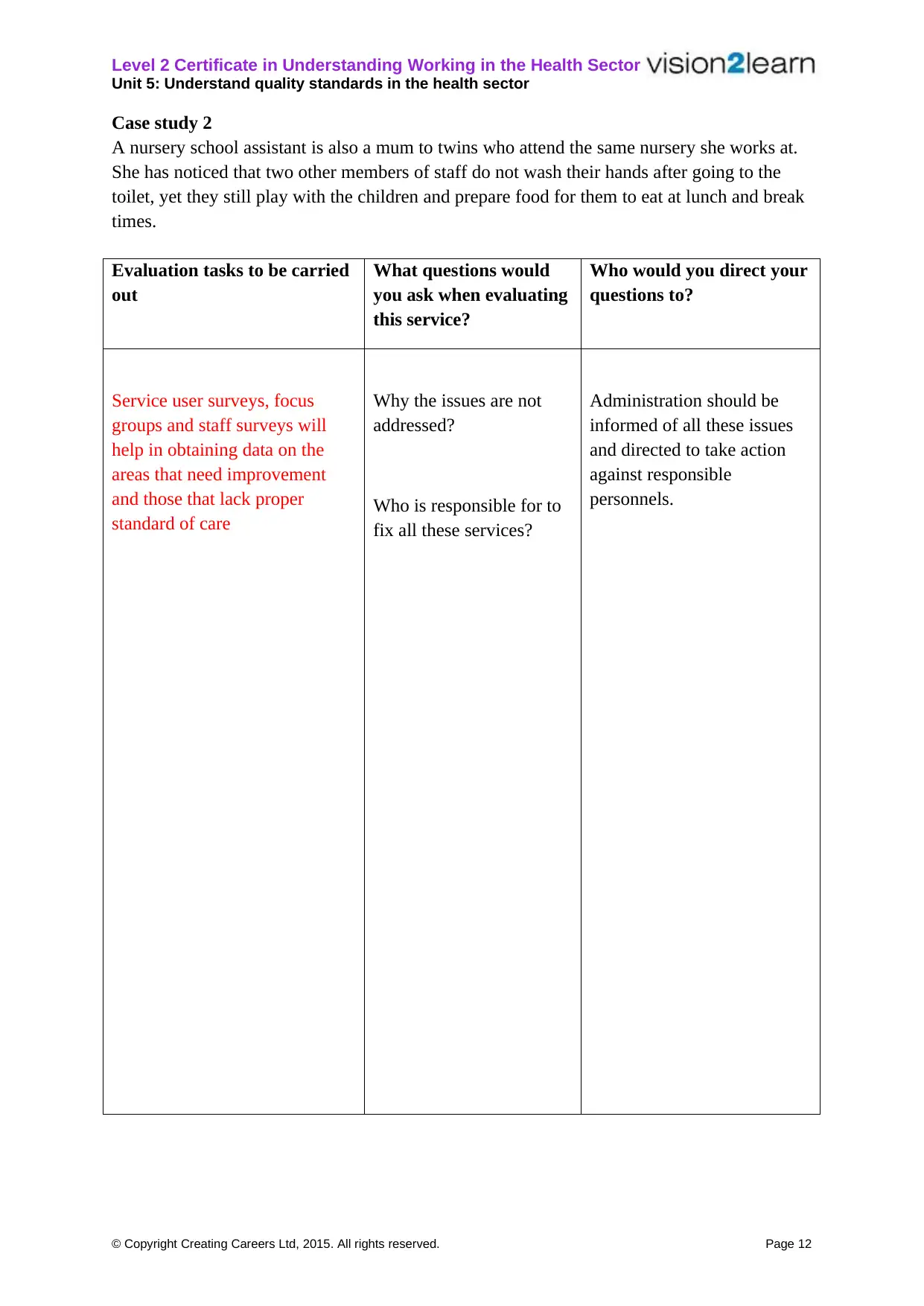
Level 2 Certificate in Understanding Working in the Health Sector
Unit 5: Understand quality standards in the health sector
Case study 2
A nursery school assistant is also a mum to twins who attend the same nursery she works at.
She has noticed that two other members of staff do not wash their hands after going to the
toilet, yet they still play with the children and prepare food for them to eat at lunch and break
times.
Evaluation tasks to be carried
out
What questions would
you ask when evaluating
this service?
Who would you direct your
questions to?
Service user surveys, focus
groups and staff surveys will
help in obtaining data on the
areas that need improvement
and those that lack proper
standard of care
Why the issues are not
addressed?
Who is responsible for to
fix all these services?
Administration should be
informed of all these issues
and directed to take action
against responsible
personnels.
© Copyright Creating Careers Ltd, 2015. All rights reserved. Page 12
Unit 5: Understand quality standards in the health sector
Case study 2
A nursery school assistant is also a mum to twins who attend the same nursery she works at.
She has noticed that two other members of staff do not wash their hands after going to the
toilet, yet they still play with the children and prepare food for them to eat at lunch and break
times.
Evaluation tasks to be carried
out
What questions would
you ask when evaluating
this service?
Who would you direct your
questions to?
Service user surveys, focus
groups and staff surveys will
help in obtaining data on the
areas that need improvement
and those that lack proper
standard of care
Why the issues are not
addressed?
Who is responsible for to
fix all these services?
Administration should be
informed of all these issues
and directed to take action
against responsible
personnels.
© Copyright Creating Careers Ltd, 2015. All rights reserved. Page 12
⊘ This is a preview!⊘
Do you want full access?
Subscribe today to unlock all pages.

Trusted by 1+ million students worldwide
1 out of 19
Related Documents
Your All-in-One AI-Powered Toolkit for Academic Success.
+13062052269
info@desklib.com
Available 24*7 on WhatsApp / Email
![[object Object]](/_next/static/media/star-bottom.7253800d.svg)
Unlock your academic potential
Copyright © 2020–2025 A2Z Services. All Rights Reserved. Developed and managed by ZUCOL.





